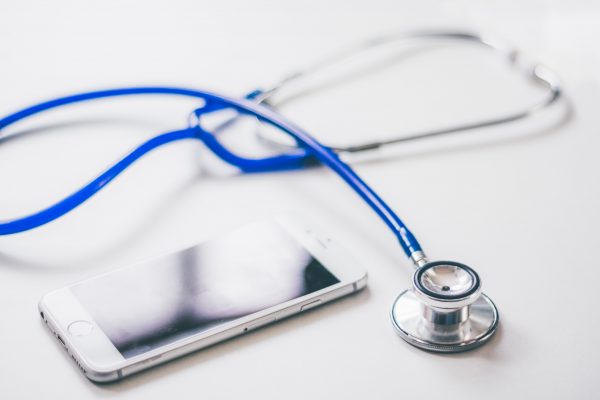Predictive medicine using IoT wearables creates new possibilities for patients to receive medical services on time. IoT software should give realistic information about their health status to doctors. Physicians make more accurate decisions based on such data.
Overview
Nowadays, IoT wearables help users track their physical activity: number of steps, sweat and glucose level, blood pressure, and other health indicators. Accurate data gathered from these devices assist in making timely and precise medical decisions.
Experts divide IoT medical portable devices into a few categories:
- Assets & Human tracking and management devices. These IoT devices can track inventory, personnel, air quality, temperature, and other parameters.
- Surgery IoT devices. AR/VR devices can assist surgeons with complicated medical operations.
- Remote patient monitoring (RPM). RPM refers to ambulance IoT, Telemedicine, and personal IoT wearables.
IoT portable devices oriented on the mass market are the most proliferated product for personal use in healthcare. They are featured to predict and prevent cardiovascular diseases (CVD), COVID-19, pneumonia, asthma, diabetes, dementia, Alzheimer’s illness, Parkinson’s disease, concussion, depression, spinal disorders, and other illnesses.
The advent of new IoT technologies led to an increasing number of different sensors which track a person’s health status parameters. According to IDTechEx “digital disruption of the healthcare sector will drive the medical wearables market to $19.7 billion by 2024.”
Customers prefer to track many healthcare parameters and monitor them using their smartphone applications. But the more sensors used, the more battery power is needed to satisfy all their wants. Various embedded sensors and applications produced by different manufacturers have their standards, which require compliance with specific regulations.
Many IoT devices, including in the healthcare sector, created massive issues. Let’s highlight among them:
- Customers maturity. 10% of the customer cease to use their wearable devices because they don’t know how they can use them.
- Professionals scarcity. Rapid IoT growth leads to a lack of human resources. High schools and courses don’t resolve this concern fully.
- Devices’ complexity and power consumption peculiarities. As mentioned earlier, the customers’ “all-in-one” wants cause IoT portable devices complexity, which leads to more extensive power consumption. Devices become more expensive and less affordable solutions for users because of technological intricacy.
- Interoperability and scalability issues. The abovementioned issues create interoperability problem, which requires specific standards for IoT creation to develop. These regulations matter because it is easy to create, operate, distribute, and debug IoT wearables at the global level.
Free access to the worldwide internet network has increased IoT security problems. Security issues include data privacy, medjacking, unauthorized access, personal health information (PHI) disclosure, DDoS attacks, etc. The more participants involved in data storage and transmission, the more risks appear. This situation means that architecture and application development should consider the most critical factors for everyone.
Patients’ data is under attack
The number of hacker attacks in the healthcare sector increased dramatically over the last five years. According to HIPAAjournal’s data, the number of breaches in healthcare rises almost every year. The more detailed information is described below (see figure 1).

Fig.1 Healthcare Records Exposed by Year
These figures surged in 2015 like crazy and then seriously decreased in the next year. But now, the number of violation cases almost doubled over the last three years. You can see this situation on the chart below (see figure 2).

Fig.2 Individuals affected by healthcare data breaches
Patients’ data exposure from IoT wearables is harmful to them. Specialists point out the most dangerous situations as follows:
- Access to users’ IoT data and possibly changing it leads to incorrect doctors’ recommendations or omitting deadly conditions. Those issues hinder the treatment process and can even cause a patient’s death. Such cases will increase since IoT data doctors use for making healthcare decisions.
- Hackers can steal information, and therefore, perpetrators can use it as ransomware or give it away to someone for a particular award.
One of the most prominent security specialists, Ramses Gallego, International CTO of CyberRes said about wearables and security that the medical Internet of Things “opens the doors for new vectors of attack, including targeted malware and distributed denial of service attacks. What happens if medical devices are compromised?”
Privacy problems organizations resolve by efficient authorization and authentication. They inform users on how to do it effectively. Paroles and two-factor authentification are a must for PHI protection. Weak paroles are easy targets for hackers, and consequently, data can be easily exposed and shared. So clients should make paroles strong with the help of unique hints or even restrictions (e.g., parole length should be more than eight symbols, and authentification using mobile phones).
What kind of information can be stolen by criminals or exposed by accident:
- Personal data: birth date, sex, age, demographics, nationality;
- Medical history: hospital information, patient’s doctor data, treatment process information,
- Device information: manufacturer’s data (serial numbers), battery power, device’s characteristics.
Gallego also emphasizes measures to resolve the privacy issue:
“Most vendors are driven by device operation rather than the data itself,” he says. As a result, robust authentication and authorization are critical to determining how devices collect, send and analyze data.
IoT wearables predict when you will fall
There is a global problem with falls, especially among the senior population. Such collapses can lead to fateful consequences like disability or even death. According to World Healthcare Organization, “approximately 37.3 million falls severe enough to require medical attention occur each year.”
To protect elderly people, technical specialists invented IoT portable devices. Those wearables monitor the users’ body position and alert them when they are going to fall.
The market for wearable devices is rapidly developing. Consumers want more and more physical status monitoring and preventive health-balancing features for their IoT devices.
But as Dr. Steven LeBoeuf says, “It is clear people want wearables that help them improve their health or medical condition, not just improve their fitness or performance.”
To maintain good health using portable IoT devices, patients need strong cooperation with the medical staff. IoT wearables experts support this thought. They highlight that: “Health data captured by wearable devices need to be shared with physicians or caregivers for monitoring and timely health interventions.”
Stop respiratory deterioration issues using IoT devices
Today respiratory illnesses take the lead among the deadliest diseases. For instance, according to World Health Organization, “Chronic Obstructive Pulmonary Disease (COPD) is the third leading cause of death worldwide, causing 3.23 million deaths in 2019.”
For the early detection of such diseases, medical facilities started to use IoT devices. They look like patches placed on the chest. Those IoT and AI-driven tools scan patients’ health status and inform physicians about harmful changes in their fitness. Sensors correlate very well with spirometers, which analyze oxygen levels in the lungs.
Medical devices are less mind-bending than IoT products. As Christopher Montalbano, co-founder & CEO of MIDI Product Development, says: “Yet, due to their unique components and related intricacies, creating wearables may prove more complicated than with your average medical product. Achieving success requires a clear understanding of these devices, their intended uses, and the processes necessary to make them both safe and maximally beneficial.”
But an increasing number of IoT portable devices can still be helpful, especially in predictive medicine. K., Geetha Poornima & Krishna Prasad, K. highlight some wearable intricacies in their studies:
“The wider the data sets, the better the probability of forecasts being correct. This sometimes contradicts the privacy principle and may jeopardize data if it is not adequately managed in compliance with laws and privacy controls. Greater dependency on technology ensures that individual need to ensure that ethical standards are continually met.
There is also a problem with low power consumption for IoT nodes backed by batteries, high-power requirements for physical devices, and, most notably, bandwidth utilization.”
The deadliest disease prevention using intelligent IoT devices
According to the World Health Organization, “cardiovascular diseases (CVDs) are the leading cause of death globally. An estimated 17.9 million people died from CVDs in 2019, representing 32% of all global deaths. Of these deaths, 85% were due to heart attack and stroke.”
So we need a robust and reliable connection between patients and medical specialists if we talk about intelligent protection from such illnesses.
There is a specific IoT solution dealing with cardiovascular diseases, consisting of four parts:
- The Patch is a device placed on the patient’s chest for real-time vital signs monitoring using sensors. It sends Electrocardiogram (ECG) data via Bluetooth.
- A smartphone receives data from the Patch and runs under a customized Android OS. This tailored Android OS allows smartphones to work in a single-application mode.
- Cloud Backend, a complex web-based application, contains:
- Cloud Backend API to exchange data between Smartphone app, BadBeats Detector Library, and frontend,
- BadBeats Detector Library for ECG analysis and beat anomalies detection (Tachycardia, Bradycardia, etc.)
- General Backend Layer for database connection, data processing, routing management, etc.
- Graphic Libraries for drawing and displaying ECG graphs and for other visualization tasks.
- Pattern detector for automated ECG patterns recognition. It’s a library/algorithm based on neural networks.
4. Frontend application is a web application for technicians, physicians, and medical to monitor patients’ vital signs via dashboards, reports, and data management.
Nowadays, it is dangerous to leave patients without professional aid and disease prevention. IoT wearables are a convenient solution, but senior people don’t always have time, desire, or ability to monitor their health status properly using it. So the first solution needs regular communication with physicians, and it can’t always prevent falls.
Energy-saving and encryption features of IoT products for CVDs give medical facilities and end-users more benefits than the IoT solution for pulmonary diseases. We can highlight the most significant ones:
- The application automatically goes to energy-saving mode (turn off the display, but keep Wi-Fi and Bluetooth running)
- The mobile application will work in a “launcher” mode and as a system app, which means “always on top” activity, and all other applications, including the Android app launcher, will be disabled for the end-user.
The launcher will have its own wi-fi configuration UI/UX and the ability to “unlock” the phone if someone enters the service master key. These measures are for maintenance and service purposes.
- BLE encryption features coders have developed according to HIPAA and other regulations.
Using encryption, energy-saving, and regular monitoring application features by technicians and professional medical teams can help patients reduce cardiovascular risk.
According to IDTechEx, there are three IoT waves of sensor and wearables development in RPM. The first is for early sensors like hearing aids and Holter monitors. The second brought sensors developed in other industries. Everyone started to use smartphones and smartwatches as fitness trackers in healthcare.
“The emerging third wave is far more targeted, with sensors ‘made for wearables’ and developed with key properties in mind like flexibility, comfort and low power usage. These are less commercially mature, but examples such as mobile cardiac telemetry and continuous glucose monitoring will see the strongest growth and relevance in the long term.” [1]
So cardiovascular illness tracking using IoT solutions has great potential to rise in the next few years.
How BLE technology assists in remote patient monitoring
Increasing energy consumption and security has become one of the major concerns for IoT wearables. Customers want more and more features and abilities for their apps. Therefore it creates new issues for technicians. Energy consumption depends on the number of the app’s features. The size of the device impacts its battery capacity. The smaller the device, the less power this battery has.
The IoT solution for CVDs uses Bluetooth Low Energy (BLE) technology, which saves more energy for users. It has special encryption to protect their privacy:
“BLE uses the AES-CCM cipher with 128-bit key length to provide data encryption and integrity over the wireless link.
AES-CCM is a FIPS 140-2 approved cipher and is also used for security in other popular applications such as WiFi WPA2 and TLS 1.3.
According to recommendation of NIST, 128-bit key length is considered secure until 2030.”
These protection measures allow safe usage of IoT portable devices for patients, caregivers, technical specialists, and medical facilities.
According to F. John Dian, R. Vahidnia, and A. Rahmati:
“The complexity of the wearable IoT devices is typically reduced due to lightweight and less power consuming designs. Consequently, there could be less strong security features on such devices.”
So IoT experts stress the importance of resolving security issues:
“One of the challenges in wearable IoT devices is how to implement security policies while keeping the complexity of the system as low as possible. In general, wearables are easy hacking targets due to poor encryption and protection.”
Some cardiology-driven types of IoT wearables don’t give the exact data to physicians. More accurate information technicians derive from special medical devices: ECG sensors, equipped with all necessary monitoring features.
The current information for The BadBeats Library provides basic estimates with no breakdown and low to medium accuracy. AI-driven app’s functionality and CVDs database curated by technicians and medical specialists create possibilities for exact doctors’ diagnoses. Most apps don’t have such features. Customers use in-app or cloud-based data storage, which doesn’t possess all AI abilities. It can be outdated or rigid and inflexible. So their usage for intelligent medicine is doubtful.
The BadBeats Library is a knowledge base that is constantly updating and gives valuable insights to physicians.
According to health experts, some wearables can’t provide clinicians with precise diagnoses:
“Still, although the gadgets are a technical achievement, some cardiologists say the information the devices produce isn’t always useful. Notifications from the devices aren’t definitive diagnoses.”
Connectivity issues of IoT devices
One of the most critical concerns about IoT devices is their connectivity. Because timely support is inevitable for patients, doctors need exact data about their patient’s health status at a particular moment.
CVDs application for IoT wearables has specific features and third-party applications for robust connectivity. Among the most relevant tools for scaling is silent app installation, which allows scaling patient data on a timeline, viewing the most critical activity in a proper visual form, select and preparing data for reports. Developers achieve scalability by using a set of Amazon services and suitable database design.
The architecture and services to build the project are the following:
Elastic Load Balancing, which automatically distributes incoming application traffic across multiple targets, such as Amazon EC2 instances, containers, IP addresses, and Lambda functions.
Remote Dictionary Server (Redis cache) for latest (last 24 hours) cardiograms is a fast, open-source, in-memory key-value data store for use as a database, cache, message broker, and queue. All Redis data resides in memory, unlike databases that store data on disk or SSDs. By eliminating the need to access disks, in-memory data stores such as Redis avoid time delays and can access data in microseconds.
Additional S3 storage for cardiograms – Amazon Simple Storage Service (Amazon S3) is an object storage service that offers industry-leading scalability, data availability, security, and performance. Customers of all sizes and industries can use it to store and protect any amount of data for a range of use cases, such as websites, mobile applications, backup and restore, archive, enterprise applications, IoT devices, and big data analytics.
RabbitMq/Kafka Queue for processing cardiograms – It is a message broker. Technicians use it to solve several needs in enterprise architectures, including managing workload queues and broadcasting messages to many subscribers. Amazon MQ is a managed message broker service for Apache ActiveMQ that makes it easier to operate and scale message brokers in the cloud.
Kubernetes cluster for automatic scaling – Kubernetes is open-source software that allows you to deploy and manage containerized applications at scale. Kubernetes manages Amazon EC2 compute instances clusters and runs containers on those instances with deployment, maintenance, and scaling processes. Using Kubernetes, you can run any containerized application using the same toolset on-premises and in the cloud.
The application and third-party software are scalable and reliable for every participant system. And as Christopher Montalbano says:
“There must be a value proposition between the device offering (paired to cloud services) and the external stakeholders such as doctors, patients, purchasing decision makers, insurance reimbursement and much more.”
Cutting-edge intelligent ECG diagnostics
Mobile cardiac telemetry (MCT) is one the most proliferated methods, which uses IoT portable devices for intelligent predictive diagnostics. Certified Cardiac Technicians (CCT) monitor patients’ healthcare status 24/7 and support them when necessary. Patients’ cardiac abnormalities become a part of the cloud-based libraries and third-party integrations, which provide technicians and physicians with relevant reports about patients’ well-being.
MCT is much better than holter technology because it is faster, timely, comfortable for everyone, and improves patient retention rates. Data transmission in almost real-time aids in emergency cases and prevents severe cardiac diseases. CCT technicians custom generate every summary, ongoing and final telemetry report for each patient. These reports contain all the necessary details and easy-to-understand for every counterpart.
A HIPAA compliant service protects the privacy and secures sensitive information from hacker attacks and other data breaches.
MCT solution doesn’t require additional capital costs for a substantial number of patient monitoring. The client’s office can be provided with the necessary equipment and technical support.
This solution gives medical providers a new opportunity for patient retention. The more patients stay with medical facilities, the more profitable those organizations will be. Clinics save costs on testing, hiring, staffing needs, and inpatient beds.
IoT wearables and mobile software for their reliable work, in this case, create extra time-saving opportunities for healthcare providers’ personnel. Technicians control patients’ health status outside the clinic, while doctors and nurses focus on the most critical inpatients.
Preventive healthcare measures are cheaper than open-heart surgeries or other traditional, quite excessive long-term hospitalized care procedures. So IoT technology reduces the need for high-quality and highly paid physicians and cardiovascular surgeons. Therefore healthcare organizations can significantly reduce doctors’ burden and save costs on new, more efficient treatment methods.
Doctors receive reports which give an overall view of patient events, such as premature ventricular contractions (PVC), premature atrial contraction (PAC), and ventricular tachycardia. All reports provide medical specialists with necessary details, giving them a clear picture of a patient’s health status. It is much better than just auto-triggered patient events because such cases are less informative. Reports can predict and prevent more severe diseases.
The health state of each patient is under control and secure protection. Physicians rely on such analytical tools for better diagnostics and, consequently better treatment processes.
The patient’s management menu allows to view/edit patient’s data, triage emergent or common events, create different kinds of reports, or split monitoring data if the patient was changed before updating this information into the system.
The “Split procedure” closes current monitoring data on a selected point on a timeline and transfers all newer data to the new patient’s account, which should be set in a pop-up after the “Split procedure” was launched. The “Close procedure” just closes current monitoring if it needs to be done earlier than the estimated “End date”.
In the case of cardiovascular diseases, appropriate support is essential. MCT services give patients everything they need including the monitoring equipment, supplies, and simple-to-follow instructions.
It is necessary to provide as many MCT recorders and patient supply kits as possible to meet the customers’ demands. This includes such low-cost materials: Mobile Cardiac Telemetry Monitors, instructions, patient diaries, electrodes, batteries, and alcohol pads.
Services also include personalized, professional cardiac monitoring and patient care. The support team doesn’t use automated phone systems, because patients value live communication. Real humans, not robots, answer all calls and can assist providers or patients equally and immediately.
Monitoring devices are incredibly user-friendly, as well as reports. Staff (CCTs, physicians, customer service) should be trained to answer patients’ emergent needs professionally.
Special emergent buttons, which patients use, allow immediate contact with appropriate specialists. Communication is encrypted, so any malicious cyber interventions are minimized.
So relevant service support is essential. As Sadiq Syed, GE Healthcare’s GM for life care solutions says:
“More broadly, with better connectivity you also have the greater potential to build applications that are real-time and provide timely insights to the clinical teams. There is of course always room for reflection and retrospect, but each patient deserves to receive the best decisions and the best care in the moments that matter.”
Conclusion
IoT solutions in the healthcare sector should be more energy-efficient, HIPAA and GDPR compliant, be more data-accurate, and provide better connectivity for every side. Intelligent IoT wearables for CVD detection and prevention can be cost-saving and convenient for technicians, doctors, and patients.
Use smart decisions for medical facilities using secure IoT applications.








